How you make a garden border on a budget – 7 really effective strategies
I’ve been researching tips for creating a garden border on a budget.
But to create an effective budget-beating strategy – and a beautiful flower border – you need to know the pros and cons of each tip. Some tips may work better for you than others.
I’m revamping my main herbaceous border completely this year.
So I’m keeping track of the costs and can show you what really works – with the figures.
And, with these tips, I’ve halved the cost of re-vamping my border.
Savings from my ‘border on a budget’ plan
Cost of replanting my 3m x 10m border before money-saving tips = £1,500. See my calculations below.
Costs are rough estimates and will differ in different currencies and areas. You may be able to save more on some categories and less on others, but this gives you an idea of what can be possible.
- Make a plan before shopping – reduces wastage in the long term
- Choose perennials rather than annual bedding flowers – reduces maintenance costs in the long term
- Buy plants in autumn for the highest discounts – £180 saved
- Re-use some existing plants (wisely) – £150 saved
- Propagate plants – £90 saved
- Grow annuals from seed – £25 saved
- Use self-seeding plants – £125 saved
- Buy smaller plants – £225 saved.
Total savings £795
Cost of re-vamping my border £705
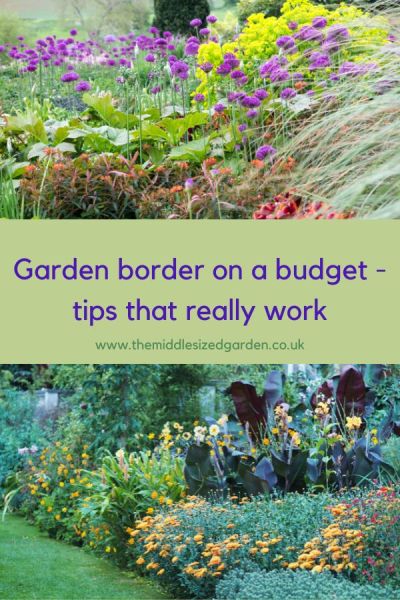
How much does it cost to plant a border?
While this will vary according to where you live (and what currency you use), there are some useful calculations you can start with to give you some guidance.
My main herbaceous border is 10m x 3m. So I checked a number of planning schemes and estimates. I checked online sales and also what I paid at my local garden centre. Prices for filling the border with plants varied wildly, but an estimate of £40-50 per square metre is a reasonable starting point.
The cost of re-planting my border would therefore be around £1,500 before implementing any budget tips. I’ve rounded that figure up a little to make calculations easier, but I also estimated the cost-saving of the tips in percentages, so it doesn’t change their impact.
Note: I checked some ‘ready-made border’ schemes while I was researching this. There are some very attractive ready-made border packages, where the planning is done for you. But when you check out their cost per sq metre, they are expensive. One well-known company sells the packages at around £100 per sq metre, which would double the cost of my border to £3,000.
However, a ready-made border scheme will often look really good. So it may be worth paying the extra if you don’t feel confident about putting plants together yourself.
Make a shopping list – even if you don’t stick to it
If you ask any garden designer how to plant a beautiful border on a budget, they will always tell you to make a list of plants before you start shopping.
Impulse buys can be expensive. And trying to create an entire border without planning could lead to a very costly plant shopping expedition. There’s also likely to be wastage, because you’ll be tempted to buy plants that look good now, leaving you with gaps to fill later in the year.

So I made a list.
There are lots of factors to be taken into account. These include height and spread of a plant, when it flowers, the colours of the flowers and foliage, whether it is wildlife-friendly, whether it prefers sun or shade and many other things.
So I put this into a grid. You could do this in Excel or download my free Beautiful Borders Planning Check List.
I spent several hours researching plants (and which variety might be best). Once I’d got the list, I had a good idea of what I wanted and where the gaps might be.
And then…
Then I went to the Great Dixter Plant Fair, held twice a year, to buy plants from good independent nurseries.
Sadly, I accidentally left my shopping list behind! However, I noticed that, after all the work I’d put in to create the list, I was much more focused on which plants I wanted. It was relatively easy to remember which types of plants I was looking for. And the nurseries had some better varieties than the ones I’d listed.
So even if you don’t follow a list, I’d very much recommend doing one.
Once home with my haul of plants, I listed the new plants in the same way, so that I could see plant heights, spread, colours etc at a glance when planting them out. It was very useful.
Making a list stops you going over budget, but it’s harder to quantify exactly how much it would save of the £1,500.
Are plant nurseries cheaper than garden centres?
No, buying from local independent nurseries won’t be cheaper. But the plants may do better in your garden, so there is likely to be less wastage.
The reason why they may do better is that they have been grown in similar weather or soil conditions to the ones you have. And they haven’t been transported hundreds of miles in trays.
It’s also hugely helpful to be able to ask about the plants. You can get advice directly from people who are growing them in similar conditions to yours.
You can often get cheap plants if you go to local plant sales or plant and seed swaps. These too will have been grown in your local climate and soil.
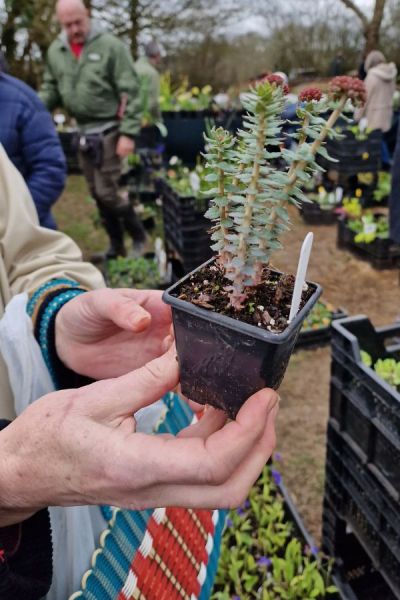
Buying from local independent nurseries that grow their own plants won’t necessarily be cheaper, but the plants are likely to do well in your soil. It’s also very useful to ask growers for their advice, so you’re likely to have less wastage further down the line. Also look for local plant and seed swaps.
Border on a budget: choose perennials and shrubs rather than annuals
Perennials are plants that last for three years or more in your garden. Shrubs are plants with a woody stem that stays above ground all year round. Shrubs can last for decades.
Annuals are plants which grow from seed, flower, then die all in one year. Biennials do the same in two.
Traditionally, the main colour in borders has come from annuals or biennials. However, this means buying new every year. And it’s also more work, because you have to plant them, feed them, deadhead them and then clear them away at the end.
Perennials and shrubs do cost more than bedding plants, but you won’t need to keep re-stocking your border. And if you buy perennials that spread, you won’t have to buy new plants to fill gaps.
However, like buying from independent nurseries, this tip is more about reducing the future costs of your gardening rather than doing a border on a budget.
With the unusually hot, dry summers many of us have experienced recently, plus unexpected bouts of colder or wetter weather, it’s also worth looking for resilient plants. I’ve compiled a list of 10 resilient perennials that have withstood several years of extremes at the Antique Perennials Nursery.
When is the cheapest time to buy plants?
If you buy plants in autumn, there are often discounts of up to 40%. It’s the end of the season and the plants don’t look as attractive.
And many people have stopped thinking about their gardens, although autumn is often a good time to plant perennials and shrubs. They get established before going dormant for the winter. Then as soon as they wake up in spring, they can get growing.
I bought 6 Geum ‘Totally Tangerine’ for £30, although they would normally have been around £48.
However, you need plants that will survive the winter in your garden or somewhere to over-winter plants.
In my experience a plant that generally survives your winters may not survive a particularly harsh winter if it’s been newly planted. So you may lose more plants to winter weather. (The geums survived well.)
But not all plants can be planted in autumn. I interviewed the UK’s top salvia expert, William Dyson, in how to grow salvias. He recommended planting salvias in late spring, even the ones that are usually hardy enough to survive our winters once established.
So I bought two salvias and kept them in the potting shed over the winter. I have just planted them and they look healthy.
So it’s reasonable to assume you could plant or buy plants for around one third of your border in the autumn with around 40% discount. That saves around £180 off the £1,500.
Re-use existing plants – wisely
When I told garden designer friends that I was completely re-vamping my border, they urged me to dig up all or most of the plants in the border first.
It’s almost impossible to create a new border if you’re wedging plants in around established plants. You need to start with a clean slate.
But it’s not realistic to dig up trees or mature shrubs, such as roses, if you want to keep them. I wanted to keep the trees and four rose bushes. I’d like to keep the irises, although I will move them slightly. It’s best to move irises after flowering, so I left those in too.
We’ve also kept some of the plants we dug up in pots. We plan to replant them elsewhere in the garden, which will mean we can re-vamp the back border on a budget as well.
I think that re-using existing plants has saved us about 10%. If you re-use much more, you may not be completely re-vamping your border. So that’s £150 off the £1500.
Of course, if you are creating a new border from scratch you won’t have existing plants. But there may be plants elsewhere in the garden you could move.
Propagate plants – ask friends for cuttings
There is always a correlation between time and money. If you have a couple of years to plan your border, you could significantly reduce your costs by propagating plants. You could almost create a free border.
Propagation is when you take a small cutting of a plant and wedge it into potting compost. It roots into a new plant. It’s not difficult, but your plant probably won’t be the size you’d want for a couple of summers. (If you want to learn propagating, the RHS have a good book, Propagating Plants: How to Create Plants for Free.) Note that links to Amazon are affiliate, see disclosure.
However, in order to get the plants you want, you will have to find a friend who has one. Then you ask them for permission to take a cutting.
Some people snip cuttings off plants secretly, but that is, legally, theft. And a garden that is open to the public can have tens of thousands of visitors a year. Even if only a small percentage snip off bits, then it can really affect the shape, pruning and health of the plants.
You also need somewhere to protect your cuttings over winter and space to grow on lots of pots. My 30 sq metre border will need around 180 plants. That’s a lot of propagating.
I took around a dozen cuttings last year, but an unexpected cold snap killed them off. I had them in the potting shed, which has been fine in the past, but small young plants are always more vulnerable. This winter’s cold snap was much harsher than usual.
I think a normal home gardener might propagate about 10-15 plants. So in theory that could be about £90 off the £1,500.
Grow annuals from seed
It’ll take a year or two for the plants in your re-vamped border to reach their full size. You can fill gaps with annuals.
A packet of seeds costs less than £5. You can grow several year’s worth of, say, cosmos from that. Ready-grown cosmos seedlings cost about £1 each. There are similar cost differences with other annuals.
You do have to have some equipment, such as seed trays and potting compost. There’s a good guide to sowing from seed here.
Growing from seed also gives you a wider choice, as not all annuals are available as plug plants.
Depending on how many annuals you use, growing from seed could save you around £25 off the £1,500.
Use self-seeding plants for a border on a budget
If you don’t already grow self-seeding plants, then this won’t save you money this year. But in future years, self-sowing plants can really fill your borders for free.
I have over 25 self-seeding plants in my garden. Around half my spring border is self-sown Smyrnium perfoliatum, Euphorbia ‘Robbiae’ and allium foliage.
I have dug up self-sown Lychnis coronaria (red campion) and re-planted it in groups in the new border for summer. I’ve also dug up some Verbena Bonariensis and replanted it.
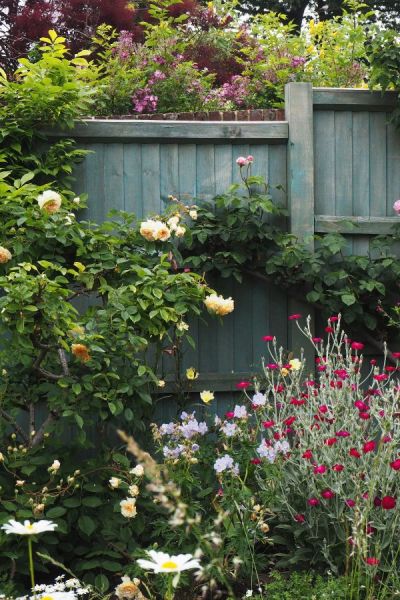
The pink flowers and grey leaves on the right are Lychnis coronaria (red campion) in a friend’s garden. It self-sows vigorously in my garden.
Self-seeders are not for you if you like to weed efficiently. When plants germinate, they all look much the same, so if you constantly weed away seedlings, you’ll be weeding out self-seeders along with the weeds.
And if you don’t already have self-seeders in your garden, you won’t save any money this year with them.
So it’s hard to quantify how much self-seeders will save you. I estimate they’ve saved me about 2-3 square metres of planting in terms of the main border in summer. That’s approximately £120.
If using self-seeders doesn’t work for you, you can probably make up some of the savings by growing more annuals from seed.
Buy smaller plants
Plants in 9cm pots are about half the cost of bigger plants in 2L containers. The plants in the 2L pots will fill your border better and flower more in the first year, but after that most smaller plants will catch up. You can plant perennials in 9cm pots straight into the earth – you don’t have to plant them in bigger pots first.
However, you don’t always have the choice between 9cm and 2L. So this saving depends on what’s on offer.
You’ll have more gaps in the border in your first year. You can fill these cheaply with those plants you grew from seed. But if you haven’t grown plants from seed, you may want to take the cost of filling gaps into account.
It’s hard to quantify how much you could save by buying smaller plants, but looking at what I’ve bought so far, I’d estimate about 30% of my plants are in 9cm pots.
So that could save me an estimated £225.
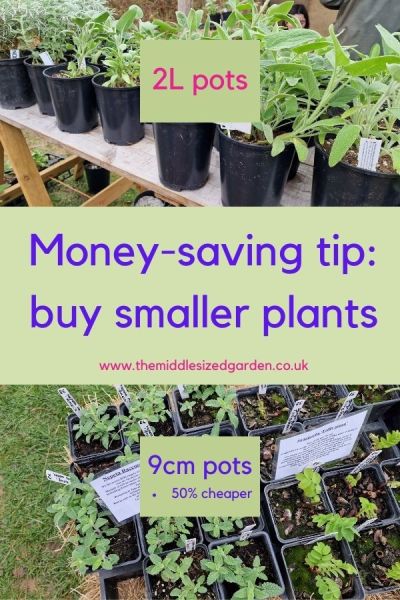
One way of doing your border on a budget is to buy smaller plants. But they will take longer to fill the space, so you may have gaps.
Pin to remember border on a budget tips
And do join us – see here for a free weekly email with more gardening tips, ideas and inspiration.
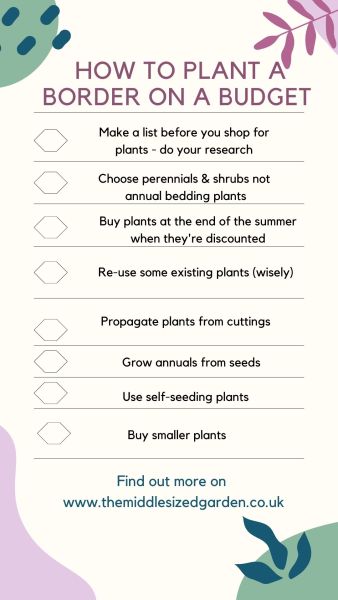
























Great advice! I have a sunny clay border where expensive perennials sulk but a few colorful annual petunia plugs thrive & cover bare spots in summer. Saves tons of money.
Sounds excellent!
Do you have some links to ready-made border schemes? I would prefer that at this stage in my gardening journey.
I do have some links, but I haven’t actually used a ready made border scheme myself, so I can’t say which ones are best or whether they are good or not. But it’s worth checking out:
https://www.crocus.co.uk/search/_/search.border-schemes/sort.0/ and https://www.waitrosegarden.com/waitrose-ready-made-borders/ and https://www.gardenonaroll.com/.
You could also consider finding a local garden designer who is happy to design just one border. This won’t necessarily be more expensive than some of the ready made borders out there, as garden designers often source the plants at wholesale. You would need to google ‘garden designer near me’ and then check to see who is happy to take on small projects.
I was so glad to see you feature Lychnis Coronaria in one of your photos. Hereabouts (Ireland) it is rarely offered for sale yet it is the plant I am most often asked about when my garden opens to the public
I love it.